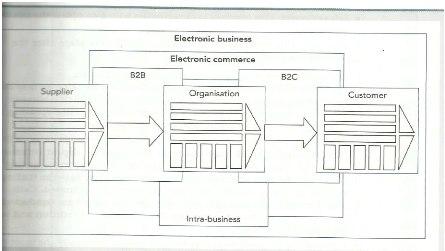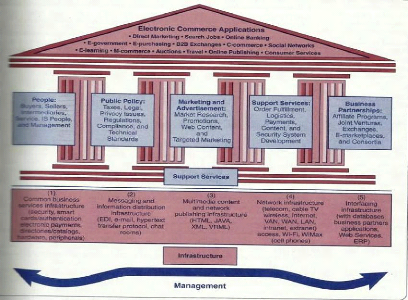II.3.1. B2C e-commerce
It is an e-commerce between a company and its customers (Paul
Beynon-Davies, 2002). Turban et al. (2008) and Kenneth C. Laudon and Jane P.
Laudon (2006) also describe B2C e-commerce as retailing transaction of goods or
services from a business to individual shoppers.
In this category of e-commerce, customers are using ICT
capabilities to buy goods and/or services from businesses and making payment
online without intermediary.
This kind of e-commerce is the most suitable to the less
developed countries because of its ease of implementation. In fact, in this
e-commerce model the infrastructure is not so sophisticated like for the B2B
e-commerce which requires advanced technology for the interaction among
business partners.
In this model, customer needs just internet connectivity and
web browser (special program to read web page) to participate to e-commerce
transactions.
Page |11
II.3.2. B2B e-commerce
As it is cleared described in the designation, B2B e-commerce
involves participation of businesses or organizations in the e-commerce
transaction.
Turban & al. (2008: p219) defines B2B e-commerce as
«transactions between businesses conducted electronically over the
internet, extranets, intranets, or private networks».
This definition shows implication of advanced technologies
which are used in the B2B e-commerce to support and operate transactions among
businesses.
II.3.3. C e-commerce
C e-commerce is the form of e-commerce where participants to
electronic transactions are individuals, not businesses.
It is «e-commerce model in which consumers sell directly
to other consumers» (Turban et al. 2008, p400).
Because consumers can't have their own infrastructure to
implement a particular e-commerce infrastructure, this form of e-commerce in
conducted using auctions which are implemented by specialized
intermediaries.
Figure 1: form of e-commerce

Source Paul Beynon-Davies (2002, p 487)
II.4. Page | 12
Mobile Commerce (M-commerce)
The definitions of e-commerce given in previous sections
stated the use of ICT to conduct commercial transaction; these technologies use
fixed computer or network access terminal.
Turban et al. (2008, p431) defines Mobile commerce as
«any business activity conducted via wireless telecommunications network.
This includes B2C and B2B commercial transaction as well as the transfer of
information and services via wireless mobile devices».
The advert of Smartphones with full keyboard capabilities and
web browser application, coupled to the new standards of broadband mobile
telecommunication (3G and 4G) which offer large bandwidth on handheld
equipments make the technology mature to conduct business online with
mobility.
II.5. E-commerce capabilities overview
Technology plays a major role in the development of the
e-commerce. However, regarding the nature of the e-commerce activity, many
other capabilities must be considered for the development of e-commerce.
To better understand capabilities concept in e-commerce it is
good to have a clear understanding of e-commerce framework as described in the
figure below.

Fig 2. E-commerce framework. Source Turban et al. (2008, p7)
Page | 13
In this framework the e-commerce is represented like a
building with three main components:
- Roof: represents the e-commerce applications
- Walls: which sustain applications represent all support
services for the e-commerce
- Foundation: represents the e-commerce infrastructure.
All these capabilities must be managed and governed in a best
way for a successful e-commerce development.
For the context of this study, payment systems can be included
in the IT capabilities for the nature of the infrastructure used for the
payment systems. Their importance for e-commerce development motivates the
choice of studying it as particular capability because it is a vital part of
the e-commerce infrastructure.
II.6. Information system capabilities
II.6.1. Introduction
This section will present definitions of capabilities and
resources which are two concepts which will be used in this work regarding
capabilities.
Day (1994) and Grant (1996) cited by Abhay N. Misha and Ritu
Argarwal (2010) define capabilities as «firms capabilities, skills, and
accumulated knowledge that enable it to repeatedly perform task that create
value».
It emerges from this definition the concept of resource which
includes «all assets, capabilities, organizational process, attributes,
information knowledge, etc, controlled by a firm that enable the firm to
conceive and implement strategies that improve its efficiency and effectiveness
(Draft 1983)» (Barney 1991,p101) cited by Aurelio Raverini (2010).
| 


